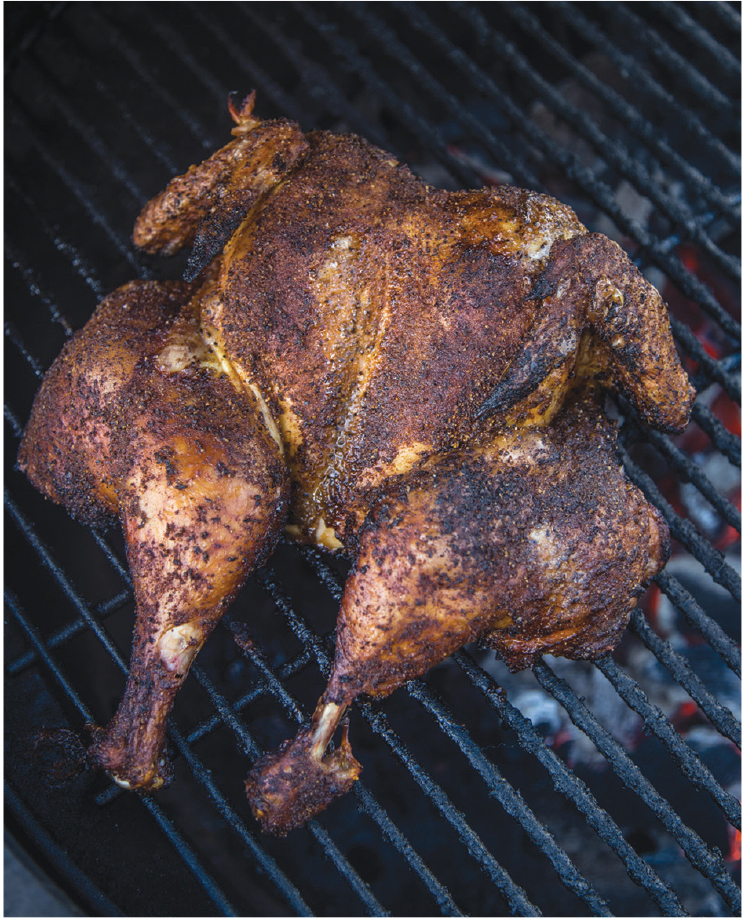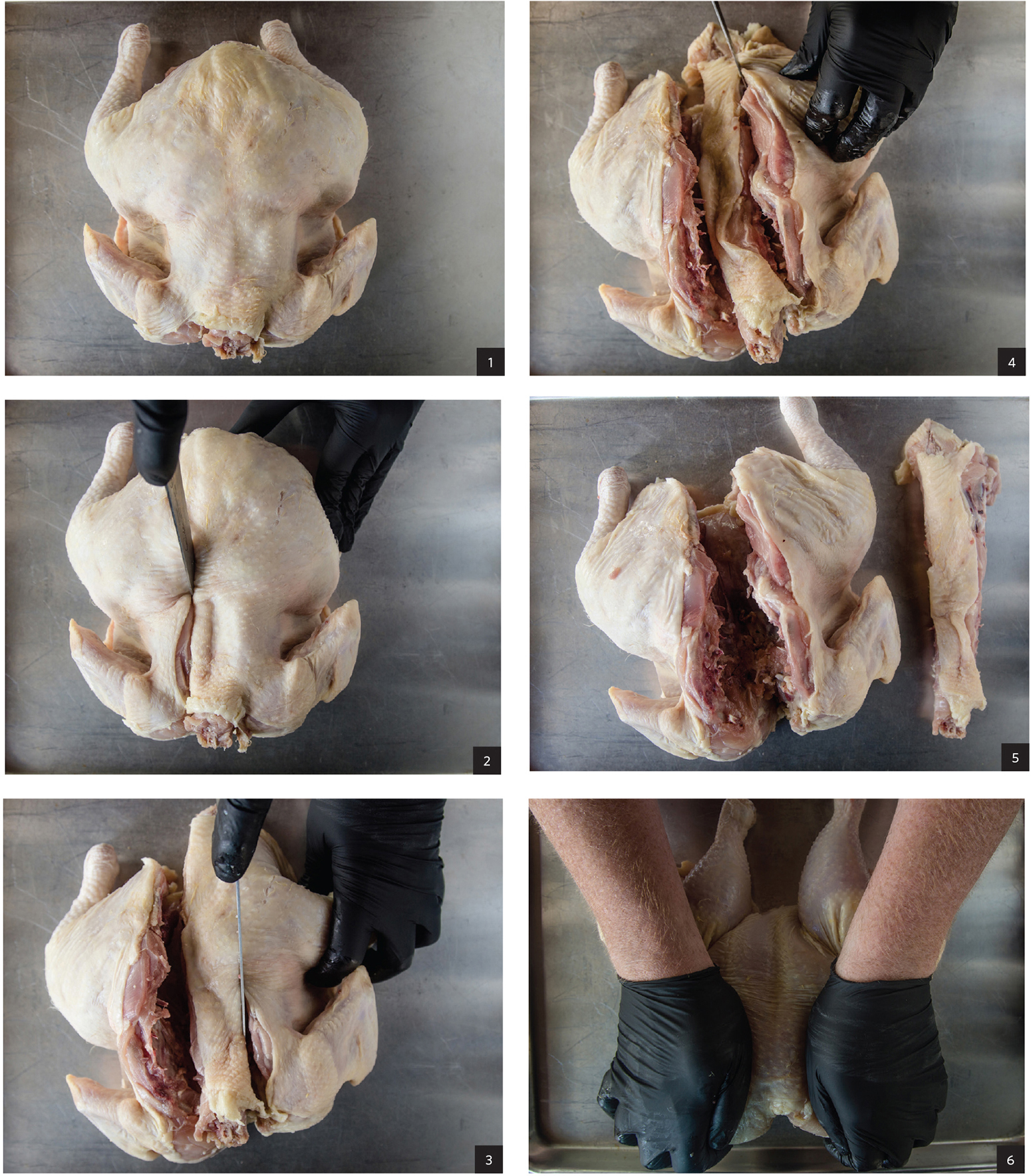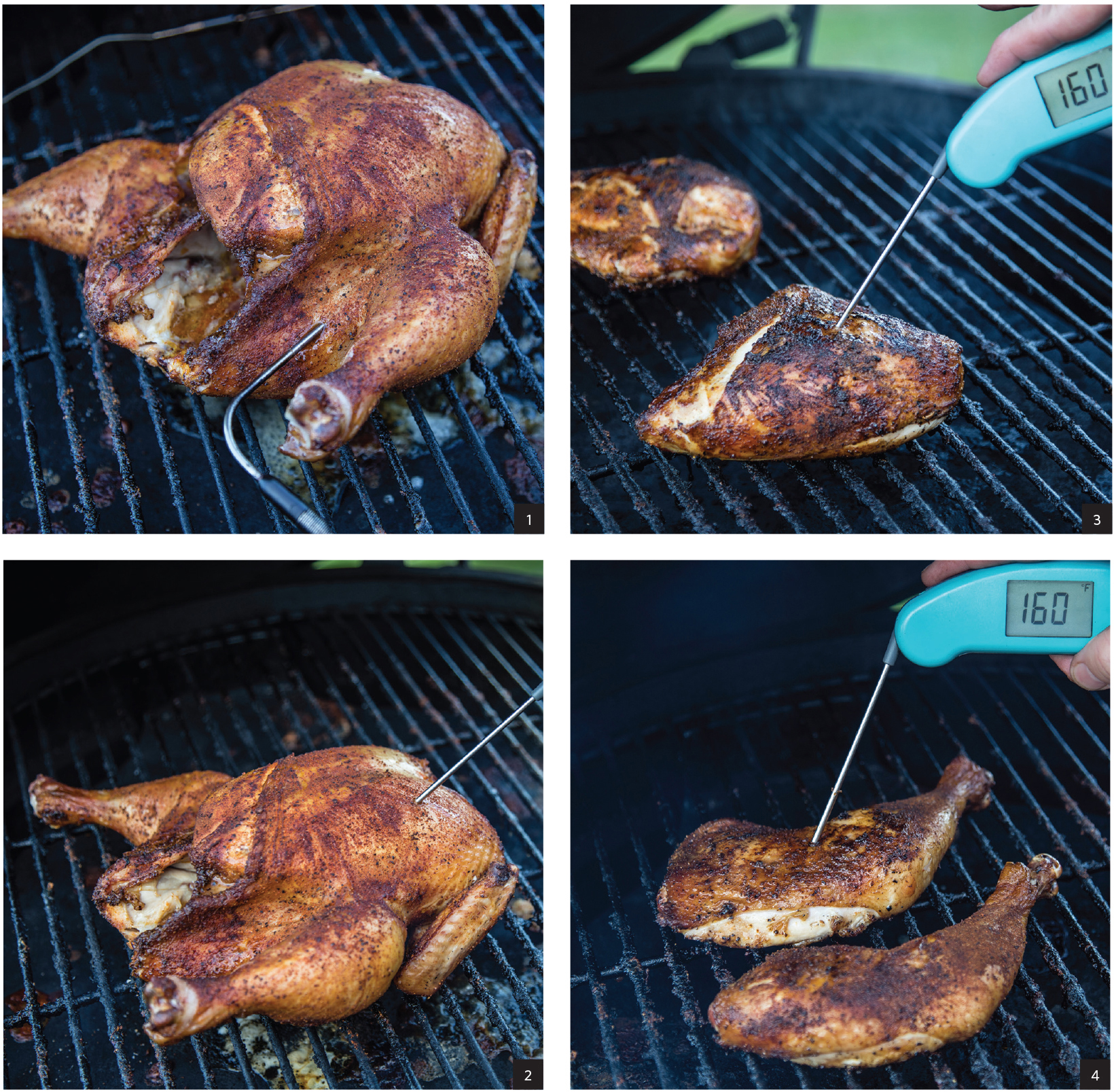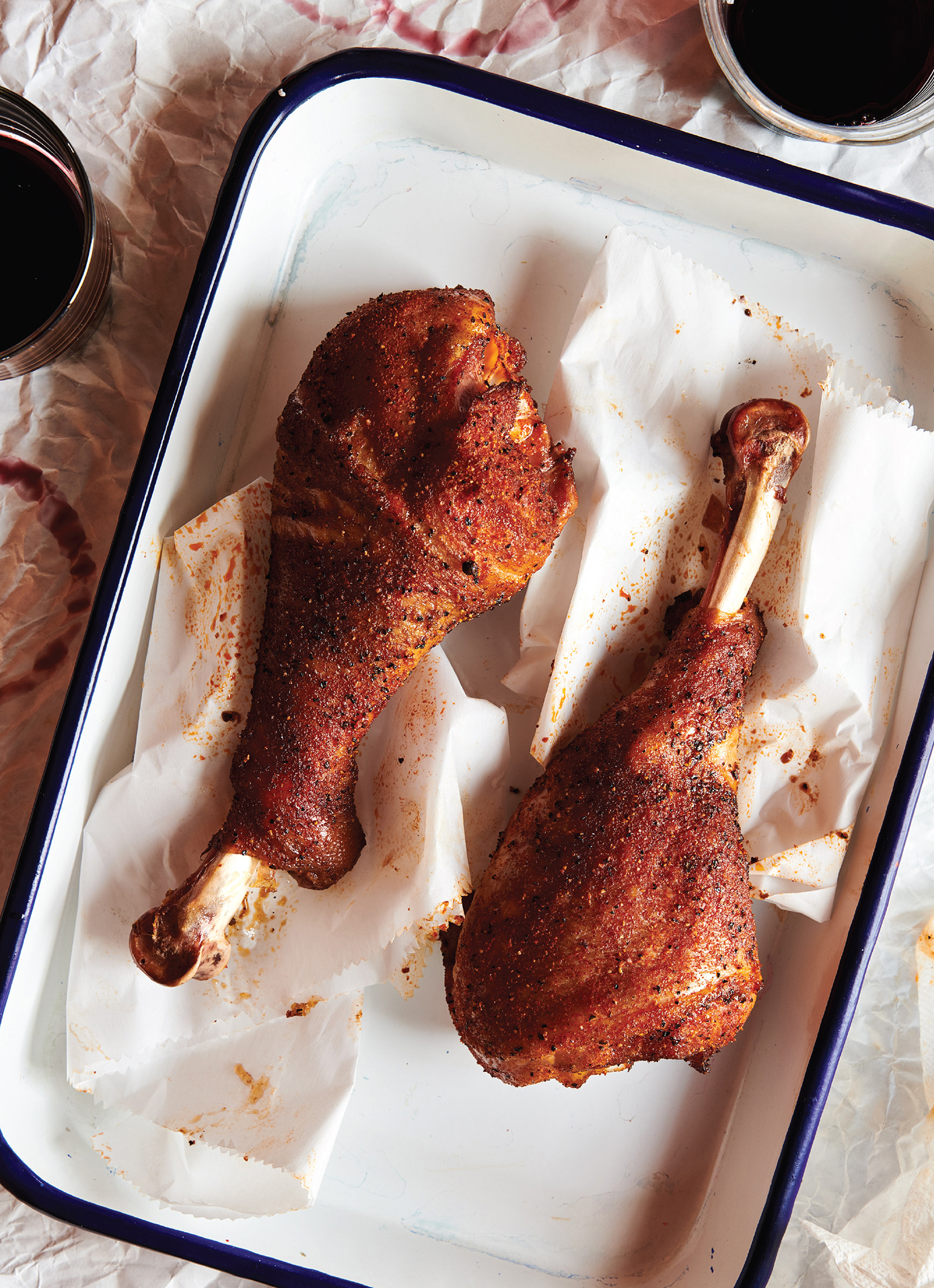
Chicken and BBQ go hand in hand, and there are several ways to prepare it that don’t result in a dry, overcooked bird. The key is knowing when to pull it from the grill or smoker.
We also have an obsession with less common fowl. Game hens make a great individual meal for a dinner party, and you can cook them easily on the smallest of grills. Duck brings a rich flavor to any dish, much like sweeter beef. And of course, turkey, that traditional bird we have smoked for decades, gives us one of the best flavors we enjoy on Thanksgiving.
This smoked whole roaster is a favorite Sunday meal for our family. Enjoy the shredded chicken leftovers for the remainder of the week, and use the remaining bones to make the most incredible Smoked Chicken Stock (this page). You’ll soon find out why this is one of the things we cook most often on the smoker.
MAKES 4 SERVINGS
1 (4- to 5-pound) whole roaster organic chicken
2 tablespoons extra-virgin olive oil
3 tablespoons Poultry Rub (this page)
1 red onion, quartered
6 cloves garlic
1 lemon, quartered
The day before cooking, coat the chicken with the oil and Poultry Rub. Make a point to season inside the cavity as well. Cover and refrigerate until just before cooking.
Preheat the smoker to 225 degrees F using applewood or cherrywood.
Stuff the cavity of the chicken with the onion, garlic, and lemon. Place the chicken on the smoker for up to 90 minutes, or until the internal temperature in the thigh and breast is 165 degrees F. It is not uncommon for the thigh to come up to temperature faster than the breast. That is fine because the dark meat can hold the higher temperature for a little longer and still be juicy.
Let sit for 10 minutes, then slice and serve. Keep the bones for stock.
WINE PAIRING: To us, this is the quintessential dish for a full-bodied chardonnay. Chardonnay has creamy, slightly fruity, lemony, and oaky notes that mirror the chicken’s mild smoky tones while having the body to match that flavorful meat. We recommend chardonnays from Oregon for their body and crisp acidity to cut through the richness of the tender chicken. Alternatively, you can reach for Rhône-style whites.

When smoking a whole chicken, don’t discard the carcass. Use those infused bones to make the most incredibly flavorful stock. It freezes perfectly in quart-size containers and keeps in the freezer for months. Use in your favorite soups and stews to give them a lovely sweet kiss of smoke (even if you’re not smoking meat for that particular soup, the smoked stock will give you the feeling you did).
MAKES 4 QUARTS STOCK
5 quarts water, plus more as needed during cooking
1 carcass from a 4- to 5-pound smoked organic chicken
3 stalks celery, cut into thirds
2 carrots, cut into thirds
1 onion, quartered
1 bunch fresh parsley (including stems or just stems if you used the leaves)
1 head garlic, unpeeled and cut in half crosswise
10 sprigs fresh thyme, or the equivalent of a small handful
1 tablespoon whole black peppercorns
2 bay leaves
In a large pot over high heat, place the water, chicken carcass, celery, carrots, onion, parsley, garlic, thyme, peppercorns, and bay leaves. The water should come high enough to just cover the chicken and veggies. Bring to a boil, then reduce to a simmer. Simmer for 4 hours covered, leaving a smidge of an opening.
Strain the contents through a fine colander (we like to strain twice—once to remove any large pieces and a second time through a very fine colander).
Chill the stock in the refrigerator overnight. The next day, remove any surface fat, then transfer the stock into quart-size containers. Use within a couple of days or freeze.
NOTE: You may find that the stock will get a bit gelatinous after it’s chilled. That’s OK (it’s actually a good thing!). Once you rewarm it, the gelatinous texture will melt away. If it’s too thick or rich for your liking, just thin it out with a bit of water. We also don’t add salt on purpose so we can add salt as we use the stock for a dish.
Duck is such a wonderful cut to cook on the grill. A duck breast has an amazing fat layer with skin that renders and crisps up to give it a distinct flavor. With a beefy meat flavor versus a chicken flavor, this wine-friendly fowl melts in your mouth. It also makes for great conversation when your friends come over wondering what’s on the grill. Don’t let the simplicity of this recipe fool you; it is full of flavor. Make sure to buy your duck from a trusted source so you can cook it to a lower temperature, giving it better tenderness.
MAKES 4 SERVINGS
4 duck breasts
1 tablespoon extra-virgin olive oil
2 tablespoons Poultry Rub (this page)
With a sharp knife, crosshatch the skin of the duck with two X marks. This will help with the rendering of the skin and flavor from the rub.
Season each duck breast with a light drizzle of oil and 1½ teaspoons of the Poultry Rub. Cover and refrigerate for at least 4 hours (up to 24 hours). Remove from the refrigerator 30 minutes before cooking.
Prepare the grill for direct/indirect cooking.
Place the duck, skin side down, over the direct heat, and cook for 3 to 4 minutes, or until a nice crust develops. Flip the duck over for 4 minutes, then move the duck to the indirect side of the grill. Cover and let cook for 4 to 6 minutes, or until the internal temperature is 140 degrees F. (While the recommended finishing temperature of poultry per USDA guidelines is 160 degrees F, we like our duck at a lower temperature, like beef, as we buy from sources we know provide quality meat.)
Remove from the grill, let sit for 5 minutes, then slice and serve.
WINE PAIRING: Pinot noir (New World and Old World), merlot, and even a young Rioja (crianza) work well.
Chicken is a flexible protein, happily adapting to any marinade, rub, sauce, or even cooking method. This highly flavorful chicken takes a long soak in a savory rosemary bath, allowing those flavors to seep in, serving to both flavor and tenderize the meat. When it’s time to grill, the moisture is spot on and the taste is drool-worthy.
MAKES 6 SERVINGS
2 cups buttermilk
1½ teaspoons chopped fresh rosemary, divided
1 teaspoon kosher salt
1 teaspoon minced garlic
3 pounds chicken pieces, drumsticks and thighs, skin on
2 tablespoons Poultry Rub (this page)
Prepare the buttermilk bath. In a 1-gallon ziplock bag, add the buttermilk, ¾ teaspoon of the rosemary, salt, and garlic. Add the chicken pieces to the bath. If the chicken thighs are large, you may have to split them between two bags. Marinate the chicken for 4 hours to 8 hours.
Remove the chicken from the bath and discard the marinade. Pat the chicken dry.
Prepare the dry rub in a small bowl by adding the remaining ¾ teaspoon of rosemary to the Poultry Rub. Season the chicken on both sides.
Prepare the grill for direct/indirect cooking.
Place the chicken over direct heat, paying attention to avoid flare-ups. Grill for 4 to 5 minutes, or until you have a nice crust. Then flip the chicken and grill the other side for 4 to 5 minutes.
Move the chicken to the indirect side of the grill and cover. Cook until the internal temperature of the chicken is 160 degrees F. Remove from the grill and let sit for 10 minutes before serving.
NOTE: If you marinate too long, the tenderizing element of the buttermilk can cause the skin to become rubbery.
WINE PAIRING: The meat is tender and full of savory flavors from that buttermilk bath with a nice crust from the grilling and a hint of herbs. Try this with a Chablis, viognier, grüner veltliner, or gewürztraminer to play with some of those herbal notes.

The flavor of smoked chicken is one of our favorites. But smoking chicken rarely results in crispy skin. There are certainly ways to achieve it, but you’ve got to get creative if you want both smoky and crispy. Similar to reverse searing a steak (this page), the idea here is to smoke the thighs at a low temperature for flavor, then finish over direct heat for sear and to crisp up that flavorful skin. Adding the sauce toward the end allows it to flavor the skin without caramelizing or burning.
MAKES 4 SERVINGS (2 THIGHS PER SERVING)
8 chicken thighs (3 pounds)
2 tablespoons extra-virgin olive oil
2 tablespoons Sweet Rub (this page)
1½ cups Pinot Noir BBQ Sauce (this page) or your favorite Kansas City–style sauce
Trim the extra fat off of the chicken thighs. Coat the chicken with the oil and apply the Sweet Rub. This can be done the day before or up to 4 hours before cooking. Keep in the refrigerator until 30 minutes before cooking.
Preheat the smoker to 250 degrees F using cherrywood or applewood.
Place the chicken on the smoker and smoke until the internal temperature of the chicken is 155 degrees F, 45 to 60 minutes. Remove the chicken from smoker and brush on ¾ cup of the Pinot Noir BBQ Sauce. Prepare the smoker for direct cooking.
Place the chicken skin side down over direct heat for about 3 minutes. Keep the lid closed to avoid flare-ups. Flip the chicken and brush on the remaining ¾ cup Pinot Noir BBQ Sauce. Close the lid and cook 3 to 4 minutes, or until the sauce sets.
Remove the chicken from the grill and let sit for 10 minutes. Serve and enjoy right off the bone with your favorite sides and a glass of wine.
NOTE: If you are cooking on a pellet grill and don’t have a direct grill feature, increase the temperature to the highest setting on your grill and place the chicken back on it for no more than 10 minutes, or until the internal temperature of the meat is 165 degrees F.
WINE PAIRING: We’re looking for something on the bold side here. The chicken has a nice, rich smoke flavor and that sweet and savory BBQ sauce. This is where we like to reach for a zinfandel or a New World syrah (something with smoky, meaty notes works great).

Game hens are a delightful treat for date night or to impress your friends. They have a similar flavor to chicken (yet are much smaller) with a slight sweet characteristic. Grilling game hens really enhances the flavors of this eclectic meat. These also make a great substitution for a whole turkey if you’re doing Thanksgiving dinner for a small group (four or fewer people).
MAKES 4 SERVINGS (HALF A HEN PER SERVING)
2 whole game hens, roughly 2½ pounds each
2 tablespoons extra-virgin olive oil
2 tablespoons Beef Rub (this page)
The day before serving, rinse and dry the game hens. Using a sharp knife, cut the hens in half so you have one side per serving as you season. Cut along the breastbone from top to bottom on both sides. Discard the breastbone or save for stock.
Coat the hens with the oil and liberally season with the Beef Rub, including the underside. Place the hens on a small baking sheet and put into the refrigerator, uncovered, for up to 24 hours. This will dry-brine and season the hens.
Remove hens from the refrigerator about 30 minutes before cooking. Prepare the grill for direct/indirect cooking.
Over direct heat, place the hens breast side down, and quickly sear for 3 to 4 minutes depending on how close the grates are to the charcoal (it could take up to 10 minutes depending on the heat source). The aim is for a nice sear as the milestone.
Flip the hens and move them to the indirect side. Cook for 10 to 15 minutes, or until the temperature in the breast and thigh are at least 160 degrees F using an instant-read thermometer.
Remove from the heat, let sit for 5 minutes, and enjoy.
WINE PAIRING: The simple preparation and quick grilling of these hens opens up to a wide range of pairing options. For white, try a chardonnay or viognier. For reds, a nice Beaujolais or a Côtes du Rhône or Rhône-style blend would work nicely.


Lay a towel on your work surface and place a large cutting board on top of it to prevent the cutting board from slipping while you cut into the bird. Put on a pair of kitchen gloves.
Remove the giblets from the bird. Place the bird so the drumsticks are facing up on the cutting board.
Hold the bird firmly with one hand to keep it stable. Using a sharp knife, cut along the spine on both sides to remove the backbone. The backbone is not the side with the breasts. You may find that the bone is not cutting. If so, slowly move your knife to either side to work your way around the bone where there is a natural break. If you force the knife into the bone, you can chip the knife.
If you have a strong set of kitchen shears, it is easiest to lay the bird breast side down on the cutting board. Then holding the bird firm, cut along either side of the backbone. Good shears should cut right through the bone.
With the backbone is removed, place the bird breast side down and pull apart the cavity so you are pulling the sides away from each other. You will hear a cracking as the breastbone breaks. Flip the bird over so the breast side is facing up. Press down to flatten it.
Pat the bird dry and remove any bone fragments on either side before seasoning or brining.
Aren’t you glad you wore the gloves?
Reserve the backbone for stock. Consider smoking or grilling it with your bird to add to the stock’s flavor.

1 Place bird breast side down, neck facing away, backbone up top, and facing you.
2 Using a sharp knife or kitchen scissors, cut from the neck down, guiding knife along backbone.
3 Repeat the cut from step 2 along other side of backbone, toward you.
4 Finish the cut and set aside the backbone.
5 Pull each side away from each other to begin opening the cavity.
6 Flip the bird so that breast is now up, and press firmly down until the bird lies flat.
Unlike the Smoked Whole Chicken on this page, this bird is spatchcocked (see this page), which allows the whole chicken to cook on the grill at a high temperature without overcooking the legs and wings, while the breast meat and thighs come to temperature. Overcooked chicken is a sad, dry predicament. You can prevent that with this failproof technique.
MAKES 4 SERVINGS
1 (4- to 5-pound) roaster chicken
1 tablespoon kosher salt
1½ teaspoons coarse ground black pepper
1 teaspoon ground coriander
1 teaspoon marjoram
½ teaspoon dried sage
1 tablespoon extra-virgin olive oil
To spatchcock, using a sharp boning knife or strong kitchen shears, cut along the backbone of the chicken on both sides to remove it (you will cut both sides).
Flip the chicken so it is breast side up, and press down on the breastbone so you flatten out the chicken. Pat dry on both sides.
In a small bowl, mix together the salt, pepper, coriander, marjoram, and sage to form a dry rub.
Coat the chicken with the oil on both sides (1½ teaspoons per side) and then liberally apply the dry rub. Place on a baking sheet and put in the refrigerator for at least 4 hours, ideally overnight.
Prepare the grill for direct/indirect cooking.
Place the chicken over direct heat, breast side down, and cover. Sear for 5 to 8 minutes, watching out for flare-ups. Flip the chicken breast side up, cover, and cook for 10 minutes. Move the chicken to indirect heat and cook until the internal temperature is 160 degrees F in the breast and the thigh. This can take another 20 to 30 minutes.
WINE PAIRING: Chardonnay is a favorite with grilled chicken prepared like this. The crispy, well-seasoned grilled meat is a great match for a full-bodied chardonnay or other favorite full-bodied white. For red, reach for Beaujolais (gamay) or a light-bodied pinot noir. When in doubt, sparkling never disappoints with this meal.

1 Take the temperature in the thigh, taking care not to touch bone.
2 Take the temperature in the breast, taking care not to touch bone.
3 Check the thickest part of an individual breast.
4 Check the thigh, taking care not to touch bone.
At the first wedding we ever catered, the bride specifically wanted a turkey drumstick similar to the ones sold at Disneyland, one of their favorite places to go as a couple. In fact, the groom even proposed wearing a Mickey Mouse costume (too cute!), so this special dish had to be represented at the wedding. One of the key identifiers of those famous turkey legs are that they taste like ham, which is a result of a brine giving it a cured characteristic. In this version, we start with a twenty-four-hour brine, then coat it with a savory and sweet rub, giving it great flavor only enhanced by the smoking process. The end result was a very happy bride and groom on their wedding day and lots of photos with the giant turkey drumsticks!
MAKES 2 DRUMSTICKS
1 quart cold water
¼ cup kosher salt
¼ cup brown sugar
1 tablespoon black peppercorns
1½ teaspoons red chili pepper flakes
1 bay leaf
2 (1-pound) turkey drumsticks, or the largest you can find
2 tablespoons extra-virgin olive oil
2 tablespoons Sweet Rub (this page)
In a large bowl, pour in the water, then add the salt and brown sugar. Stir until the salt and sugar are dissolved. Add the peppercorns, pepper flakes, and bay leaf and stir again. Place the turkey drumsticks in a 1-gallon ziplock bag, then pour in the brining liquid. Brine for 10 to 24 hours.
Remove the drumsticks from the brining liquid, rinse with cold water, and pat dry with a paper towel.
Apply 1 tablespoon of the oil and 1 tablespoon of the Sweet Rub to each of the drumsticks.
Preheat the smoker to 275 degrees F. Place the drumsticks in the smoker for 90 minutes, or until the internal temperature is 165 degrees F. Let sit for 10 minutes and then enjoy! No forks required. But, of course, you can cut it off the bone for smaller portions.
WINE PAIRING: There are lots of options for this showstopper of a dish, such as a medium-bodied zinfandel, Oregon pinot noir, Beaujolais, Spanish garnacha, and deeply colored rosé (particularly from Spain). Choose your favorite and you can’t go wrong.

There’s nothing like a perfectly cooked smoked turkey on Thanksgiving. The problem with a huge whole turkey is that those smaller pieces cook at different times, often leaving the wings or legs overcooked while the breast and thighs come to temperature. Spatchcocking is a fantastic way to get a more even cook for all parts of the bird. It’s not your typical table-side presentation for the holiday bird, but it still makes for a dramatic look. The best part is that it has incredible flavor and everything is cooked to perfection.
MAKES 8 TO 10 SERVINGS
For the turkey
1 (12- to 14-pound) unbrined turkey
¼ cup extra-virgin olive oil
½ cup Poultry Rub (see this page)
For the brine
8 quarts water
3 cups apple juice
1½ cups kosher salt
2 apples, quartered
1 white onion, quartered
½ cup honey
½ cup dark brown sugar
3 tablespoons black peppercorns
1 tablespoon red chili pepper flakes
2 bay leaves
To prepare the turkey, spatchcock it following the instructions on this page.
To prepare the brine: 24 hours in advance, in a large stockpot, add the water, apple juice, salt, apples, onion, honey, sugar, peppercorns, pepper flakes, and bay leaves. Stir to combine. Add the turkey to the brine.
Place the stockpot in the refrigerator until ready to cook. If your refrigerator is not big enough, then place it in a large cooler with ice. You could also transfer the contents to a large brine bag and place it inside a cooler with ice. They key is to keep the turkey and brine cold at refrigerator temperature.
After 24 hours in the brine, remove the turkey and discard the brine. Rinse the turkey and pat dry. Lay out the turkey on a baking sheet and put it in the refrigerator, uncovered, for 1 hour to dry the turkey.
Remove the turkey from the refrigerator and pat dry one more time. A dry turkey is important when seasoning. To season the turkey, flip it breast side down. Coat the bottom of the turkey with half of the oil and half of the Poultry Rub. Flip the turkey over and repeat on the breast side.
Prepare the smoker to 275 degrees F using hickorywood. Place the turkey on the smoker, breast side up and laid out with the drumsticks facing toward each other and the wing tips tucked under the breastbone (see the photo on this page). Insert two meat thermometer probes, if possible, one into the breast and the other into the drumstick to monitor the temperature.
Remove the turkey from the smoker when the internal temperature of the breast and thighs is 165 degrees F. Let sit for 20 minutes, then carve and serve.
WINE PAIRING: The holiday bird is one of many flavorful foods on the table competing for attention. When it comes to pairing wine with a holiday meal, such as Thanksgiving, our rule of thumb is to have at least one crowd-friendly white wine (such as chardonnay or riesling), one all-purpose red (like pinot noir or zinfandel), and always a sparkling wine (domestic sparkling wines are our preference for this holiday, either from Oregon or California). All of these will work wonders with the turkey, as well as with the typical side dishes.